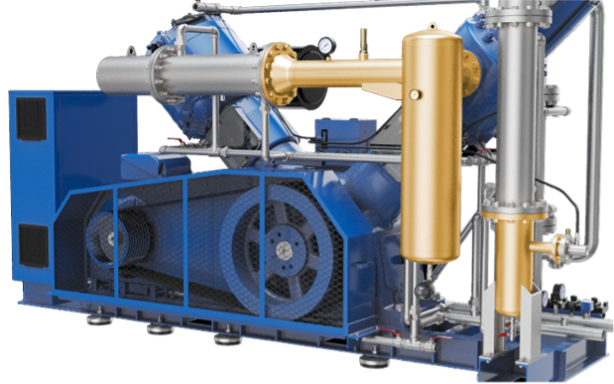Stepper compressors are compressors which are utilized to provide high pressures to air. During the operation of these compressors, water vapour in the air gets condensed due to temperature and pressure variances following the compression process and then moves to the pressurized line.
In the outlet of each step, the air gets heated as it becomes pressurized. The heated compressed air is subsequently cooled before proceeding to the next compression step, where the water molecules in the compressed air are released due to temperature differences. It's crucial to separate the compressed air from the condensed water that forms after cooling before it proceeds to the next step. Failure to separate them leads to reduced system efficiency and shortened compressor lifespan, and it eventually results in damage. Drainage of condensed water is essential for the compressor to operate efficiently and safely. This process is typically accomplished by using water separators, filtration systems or air dryers. Water separators effectively separate water from the compressed air and provide a mechanism for its discharge. Air dryers work to diminish the moisture content in the air, thereby reducing the risk of condensation.
Water separators play a key role in isolating condensed water from the compressed air. The efficiency of the separator directly impacts the compressor's lifespan.
Condensed water separated from compressed air in water separators must be regularly drained. This drainage can be carried out using solenoid valves, actuators or float evacuation devices that operate mechanically with an open-close logic.
The discharge of condensed water is just as crucial as the effectiveness of the water separator. Regardless of how efficient the water separator may be, improper drainage can lead to the reintroduction of separated water into the compressed air, thus it will shorten the compressor's lifespan.
The quantity of water generated in stepper compressors results from the condensation of water vapour in the air during the compression of atmospheric air. Condensation of water vapour occurs when the air gets heated during compression and then gets cooled. To calculate this quantity, tables of saturated water vapour and certain thermodynamic calculations are typically used. In the calculation of the amount of condensed water, it's essential to know the following parameters.
Firstly, the initial conditions must be determined. These conditions include atmospheric pressure, ambient temperature, compressor capacity, and percentage of humidity in the environment.
Secondly, the parameters that change after the compression process should be identified. Step outlet pressure and step outlet temperature are the most important parameters here.
During the third step, certain parameters undergo changes due to the cooling process. These include the temperature of the compressed air after cooling. The cooling process results in the condensation of water vapour in the air. With all these known parameters, the amount of water that needs to be condensed can be calculated over a certain period of time. Here the saturated water vapour pressure is reached via a psychrometric diagram.
The effectiveness of water separators can be seen in advance with computer-aided flow analyses or by testing. To do so, the compressor must be operated until it reaches a steady state. Theoretically, all parameters employed in the calculation should be measured during the test. Additionally, the condensed water, separated from the compressed air by the water separator, should be collected in an external container for a certain period. At the end of this time period, the accumulated water volume in the container must be measured. When the amount of condensed water which will be formed according to the theoretical calculation and the amount of water accumulated during the test are proportional in percentage, the efficiency value of the water separators employed in the compressor is seen as a percentage.
In Image 1 and Image 2, the water separators of the three-step water-cooled piston-type compressor are shown in yellow. In this compressor, at the outlet of each step, the water that condenses in the compressed air after passing through the heat exchanger is separated from the compressed air. This separated condensed water is then discharged from the bottom of the separator. Consequently, the compressed air proceeds to the next step in a dry condition. This way of operation significantly extends the maintenance life of various compressor components, particularly the rings and valves.

Image 1: Stepper Separator

Image 2: Stepper Separators
In addition to determining dimensions during the water separator design, the material selection is also quite critical. Since the water can cause corrosion on the inner surface over time, the choice of material should be based on not causing any corrosion on the pressure line.